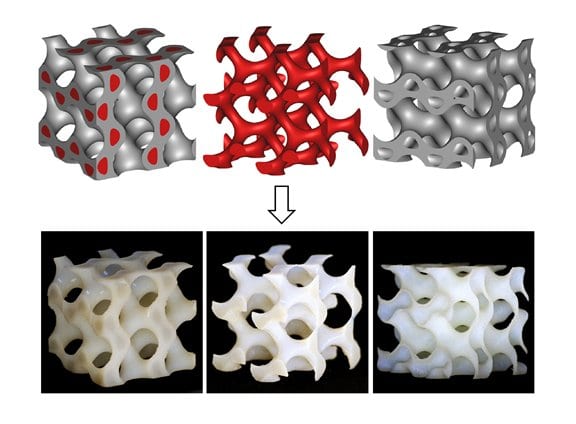Complex architected materials can be fabricated using advanced 3D printing techniques. The topological complexity of such structures can be employed to tune the mechanical and physical properties of materials. New work published in Advanced Engineering Materials proposes the use of Polyjet 3D printing technology to fabricate novel complex and architected lightweight cellular co-continuous composites (also referred to as cellular interpenetrating phase composites). Co-continuous here means separating the space into two continuous solid volumes where each volume is assigned a different material. Polyjet 3D printing technology allows the simultaneous printing of two or more materials with distinctive properties. The architecture (or topology) of the proposed cellular co-continuous composites is based on gyroidal structures that can be observed in nature in, for example, cell membranes and butterfly wings.
Gyroid, which was discovered by Alan Schoen in 1970 while working at NASA, is a mathematical minimal surface with non-self-intersections that is infinitely triply periodic (i.e., can be repeated periodically along three perpendicular directions). In fact, the gyriodal structure is a unique structure that can be tessellated periodically in the 3D space to create any desired structural system. The proposed co-continuous gyroidal composite consists of a rigid skin/shell embracing a soft core. The contrast in mechanical properties of the distinctive phases, as well as their volume fractions, provide opportunities to engineer the material and achieve enhanced properties. A wide range of samples with different densities (or equivalently different porosities) and solid volume fractions of the constituent phases have been designed, fabricated, and mechanically tested in order to assess their mechanical performance. Results showed that a wide range of mechanical properties can be obtained by varying the composition and porosity (55% to 85% air) of the cellular co-continuous composite. Also, the shell-core configuration and complex topology of the gyroidal structure allowed for accessing toughness (i.e., ability of the material to absorb energy) values that are not realized by the constituent materials independently, showing the suitability of these cellular co-continuous composites for mechanical energy absorption applications such as resistance of impact loading or blast.

















